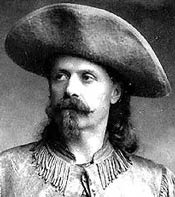(1846-1917)

William F. Cody came to embody the spirit of the West in a life that was part legend and part fabrication, a national myth of frontier life that still endures today.
He was born in Scott County, Iowa in 1846 and he grew up on the prairie. When his father died in 1857, his mother moved to Kansas, where Cody worked for a wagon freight company as a mounted messenger and wrangler. He tried his luck as a prospector in 1859 during the Pikes Peak gold rush, and the next year, he joined the Pony Express which had advertised for “skinny, expert riders willing to risk death daily.” Cody was a mere 14 years old.
During the Civil War, Cody served first as a Union scout in campaigns against the Kiowa and Comanche, then in 1863 he enlisted with the Seventh Kansas Cavalry, which saw action in Missouri and Tennessee. After the war, he married Louisa Frederici in St. Louis and continued to work for the Army as a scout and dispatch carrier, operating out of Fort Ellsworth, Kansas.
It was in 1867 that Cody took up the trade that gave him his nickname, hunting buffalo to feed the construction crews of the Kansas Pacific Railroad. By his own count, he killed 4,280 head of buffalo in seventeen months. He supposedly won the nickname of “Buffalo Bill” in an eight-hour shooting match against hunter William Comstock.
Beginning in 1868, Cody returned to his work for the Army as chief of scouts for the Fifth Cavalry. He took part in 16 battles, including the Cheyenne defeat at Summit Springs, Colorado in 1869. He was awarded the Congressional Medal of Honor in 1872 for his years of service. But the award was revoked in 1916 on the grounds that Cody was not a regular member of the armed forces at the time. (In 1989, the award was reinstated posthumously).
As Cody was earning a reputation for skill and bravery in real life, he was also becoming a national folk hero, as “Buffalo Bill,” in the dime novels of Ned Buntline (E. Z. C. Judson’s pen name). Beginning in 1869, Buntline created a Buffalo Bill – a mixture of fact and romantic fiction – who ranked along with Davy Crockett, Daniel Boone and Kit Carson in that department.
In 1872 Buntline persuaded Cody to assume this role on stage by starring in his play, The Scouts of the Plains, and though Cody was never a polished actor, he proved to be a natural and enthusiastic showman. Despite a falling out with Buntline, Cody remained an actor for eleven seasons, and became an author as well, producing the first edition of his autobiography in 1879 and publishing a number of his own Buffalo Bill dime novels. Eventually, there totaled some 1,700 of these marvelous frontier tales, most of which were written by Prentiss Ingraham.
Despite show business success, Cody couldn’t keep away from the traditons of the West. Between theater seasons, he escorted rich Easterners and European nobility on Western hunting expeditions, and in 1876 he was called back to service as an army scout in the campaign that followed Custer’s defeat at the Little Bighorn. It was on this occasion that Cody added a new chapter to his legend by engaging in a “duel” with Cheyenne chief Yellow Hair, whom he supposedly first shot with a rifle, then stabbed in the heart and finally scalped “in about five seconds”, according to his own account. Others described the encounter as hand-to-hand combat, and misreported the chief’s name as Yellow Hand. Still others said that Cody merely lifted the chief’s scalp after he had died in battle. Truth or fiction, Cody had the event manufactured into a melodrama — Buffalo Bill’s First Scalp for Custer — for the fall theater season.
It was William F. Cody, who in 1883 organized Buffalo Bill’s Wild West, an outdoor extravaganza that dramatized some of the most picturesque elements of frontier life: a buffalo hunt with real buffalos, an Indian attack on the Deadwood stage with real Indians, a Pony Express ride, and at the climax, a tableau presentation of Custer’s Last Stand in which some Lakota who had actually fought in the battle played a part. It has been described as half circus and half history lesson and the show proved an enormous success. It toured the country for three decades and played to enthusiastic crowds across Europe.
In later years, Buffalo Bill’s Wild West starred sharpshooter Annie Oakley, the first “King of the Cowboys” Buck Taylor, and for one season, Chief Sitting Bull – “the slayer of General Custer”. Cody even added international flavor to the event by assembling a “Congress of Rough Riders of the World” that included cossacks, lancers and other Old World cavalrymen along with the vaqueros, cowboys and Indians of the American West.
Despite his great theatrical celebrity, Cody still had a real-life reputation in the West, and in 1890 he was called back by the army once more during the Indian uprisings associated with the Ghost Dance. He came with some Indians from his troupe who proved effective peacemakers, and even traveled to Wounded Knee after the massacre to help restore order.
Cody made a fortune from his show business exploits but lost it to mismanagement and dubious investments. Even his Wild West show was eventually lost to creditors. Cody died on January  , 1917, and is buried in a tomb blasted from solid rock at the summit of Lookout Mountain near Denver, Colorado.
, 1917, and is buried in a tomb blasted from solid rock at the summit of Lookout Mountain near Denver, Colorado.





